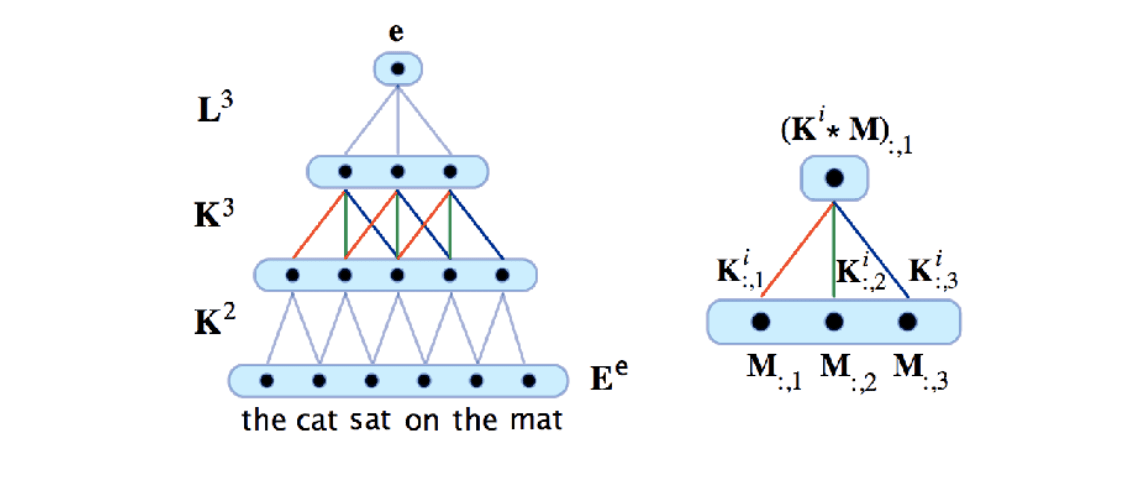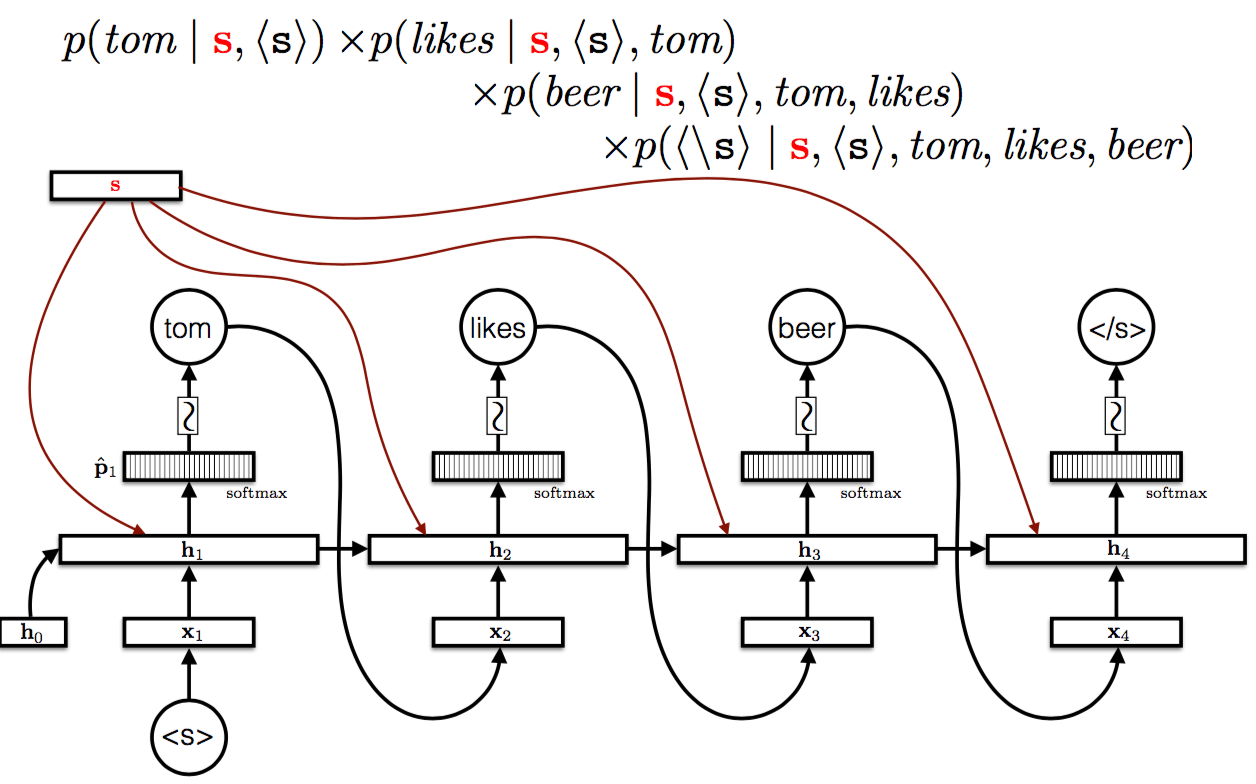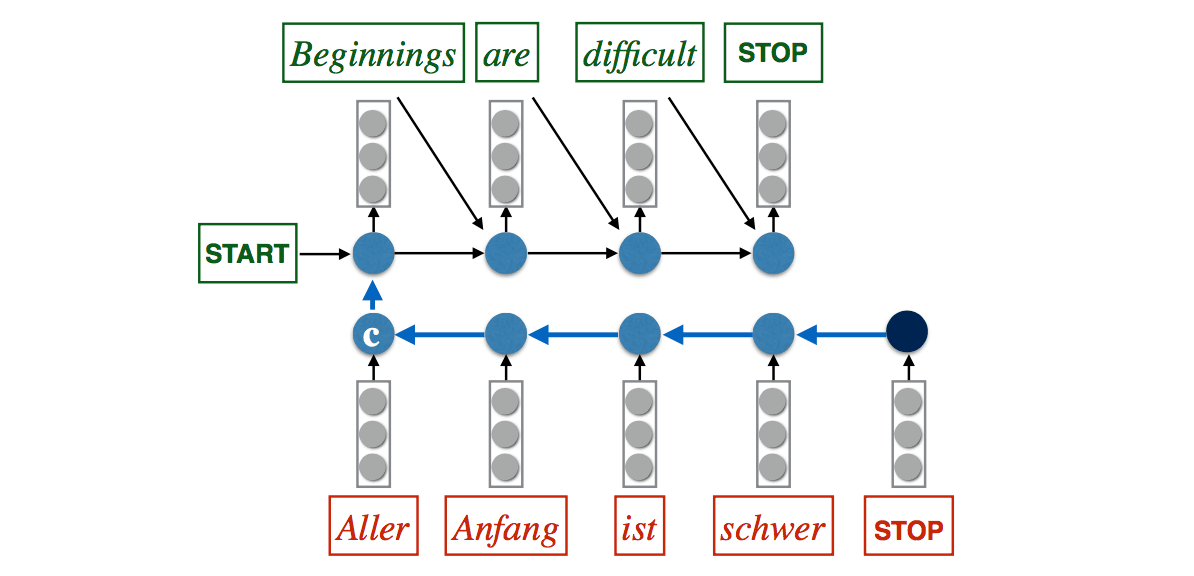A conditional language model assigns probabilities to sequences of words, \(w = (w_1, w_2, …, w_l)\), given some conditioning context, x.
As with unconditional models, it is again helpful to use the chain rule to decompose this probability: \[ p(w|x) = \prod_{t=1}^lp(w_t|x, w_1, w_2, ..., w_{t-1}) \]
| x "input" | w "text output" |
|---|---|
| An author | A document written by that author |
| A topic label | An article about that topic |
| {SPAM, NOT_SPAM} | An email |
| A sentence in French | Its English translation |
| A sentence in English | Its French translation |
| A sentence in English | Its Chinese translation |
| An image | A text description of the image |
| A question + a document | Its answer |
| A question + an image | Its answer |
To train contitional language models, we need paired samples, \(\{(x_i, w_i)\}\).
Algorighmic challenges
We often want to find the most likely \(w\) given some \(x\). This is unfortunately generally and intractable problem. \[ w^* = \arg \max_wp(w|x) \] We therefore approximate it using a beam search or with Monte Carlo methods since \(w^{(i)} \approx p(w|x)\) is often computationally easy.
Evaluating conditional LMs
We can use cross entropy or preplexity, it's okay to implement, but hard to interpret.
Task-specific evaluation. Compare the model's most likely output to human-generated expected output using a task-specific evaluation metric \(L\). \[ w^* = \arg \max_wp(w|x)\ \ \ \ \ L(w^*, w_{ref}) \] Examples of \(L\): BLUE, METEOR, WER, ROUGE, easy to implement, okay to interpret.
Encoder-Decoder


Two questions
- How do we encode \(x\) as a fixed-size vector, \(c\) ?
- How do we condition on \(c\) in the decoing model?
Kalchbrenner and Blunsom 2013
Encoder \[ c = embed(x) \]
\[ s = Vc \]
Recurrent decoder \[ h_t = g(W[h_{t-1}; w_{t-1}] + s + b) \]
\[ u_t = Ph_t + b' \]
\[ p(W_t|x, w<t) = softmax(u_t) \]
CSM Encoder
How should we define \(c = embed(x)\) ?
Convolutional sentence model(CSM)

Good
- By stacking them, longer range dependencies can be learnt
- Convolutions learn interactions among features in a local context
- Deep ConvNets have a branching structure similar to trees, but no parser is required
Bad
- Sentences have different lengths, need different depth trees; convnets are not usually so dynamic, but see Kalchbrenner et al. (2014). A convolutional neural network for modelling sentences. In Proc. ACL.

Sutskever et al. (2014)
LSTM encoder
- \((c_0, h_0)\) are parameters
- \((c_i, h_i)\) = LSTM(\(x_i, c_{i-1}, h_{i-1}\))
The encoding is \((c_l, h_l)\) where \(l = |x|\)
LSTM decoder
- \(w_0 = <s>\)
- \((c_{t+l}, h_{t+l}) = LSTM(w_{t-1}, c_{t+l-1}, h_{t+l-1})\)
- \(u_t = Ph_{t+l} + b\)
- \(P(W_t|x, w<t) = softmax(u_t)\)

Good
- RNNs deal naturally with sequences of various lengths
- LSTMs in principle can propagate gradients a long
- Very simple architecture
Bad
- The hidden state has to remember a lot of information!
Tricks
Read the input sequence "backwards" : +4 BLEU

Use an ensemble of J independently trained models.
- Ensemble of 2 models: +3 BLEU
- Ensemble of 5 models; +4.5 BLEU
A word about decoding
In general, we want to find the most probable (MAP) output given the input, i.e. \[ \begin{align} w^* = \arg\max_{w}p(w|x) = \arg \max_w\sum_{t=1}^{|w|}\log p(w_t|x, w_{<t}) \end{align} \] This is, for general RNNs, a hard problem. We therefore approximate it with a greedy search: \[ \begin{array}{lcl} w_1^* = \arg\max_{w_1}p(w_1|x)\\ w_2^* = \arg\max_{w_2}p(w_2|x, w_1^*)\\ ...\\ w^*_t = \arg\max_{w_t}p(w_t|x, w^*_{<t}) \end{array} \] A slightly better approximation is to use a beam search with beam size \(b\). Key idea: keep track of top b hypothesis. Use beam search: +1 BLEU

Kiros et al.(2013)
Image caption generation
- Neural networks are great for working with multiple modalities - Everything is a vector!
- Image caption generation can therefore use the same techniques as translation modeling
- A word about data
- Relatively few captioned images are avaliable
- Pre-train image embedding model using another task, like image identification (e.g., ImageNet)
Look a lot like Kalchbrenner and Blunsom(2013)
- convolutional network on the input
- n-gram language model on the output
Innovation: multiplicative interactions in the decoder n-gram model
Encoder x = enbed(\(x\))
Simple conditional n-gram LM: \[ \begin{array}{lcl} h_t = W[w_{t-n+1}; w_{t-n+2};...; w_{t-1}] + Cx\\ u_t = Ph_t+b\\ p(W_t|x, w_{t-n+1}^{t-1}) = softmax(u_t) \end{array} \] Multiplicative n-gram LM:
- \(w_i = r_{i,j,w}x_j\)
- \(w_i = u_{w,i}v_{i,j}\ \ \ \ \ \ \ \ (U\in R^{|V|*d}, V \in R^{d*k})\)
- \(r_t = W[w_{t-n+1}; w_{t-n+2};...; w_{t-1}] + Cx\)
- \(h_t = (W^{fr}r_t)\odot (W^{fx}x)\)
- \(u_t = Ph_t + b\)
- \(p(W_t|x, w_{<t}) = softmax(u_t)\)
Two messages:
- Feed-forward n-gram models can be used in place of RNNs in conditional models
- Modeling interactions between input modalities holds a lot of promise
- Although MLP-type models can approximate higher order tensors, multiplicative models appear to make learning interactions easier